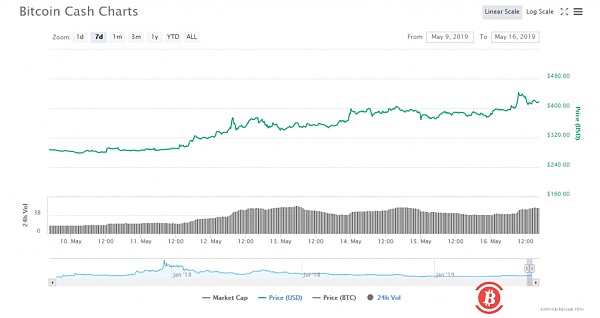The short-selling block is controversial, and the bitcoin cash centering falls into a real hammer?

Or will usher in the outbreak of BCH
According to the roadmap for development, the BCH network upgrades its core code every six months to add new features to increase scalability, privacy and overall network performance.
- Musk talks about V God, how the blockchain brings the personal data protection revolution
- Facebook can bypass the Indian central bank encryption ban, indicating that its currency is only points
- The highest price is $8,200! What is the logic of this round of bitcoin skyrocketing?
At 8 o'clock last night, BCH ushered in a fourth upgrade, which included Segwit (segregation witness) recovery and increased Schnorr signature.
From the outside world, this BCH upgrade is undoubtedly a good reason, because:
(1) The Segwit recovery feature allows BCH network participants to recover funds sent to the Segwit address. In short, after May 15th, once the P2SH redemption script is pre-imaged (for example, by spending coins from the corresponding BTC address), any miner can get the coins;
(2) In the past, BCH used ECDSA (Elliptic Curve Digital Signature Algorithm) for transaction signature, and once the digital signature scheme "Schnorr signature" invented by the famous mathematician Claus Schnorr was added, the privacy of BCH can be greatly improved. And trading ability, and reduce the current transaction size by about 4%. In addition, future Schnorr-related upgrades can enhance public signature aggregation, reducing blockchain storage and bandwidth by 20%-25%, and programmers can design complex smart contracts.
The problem of centralization?
Last night, a technical failure was suspected after the BCH upgrade. According to the cashcoin.dance browser record, in the nearly 2 hours, 10 blocks were dug up, but all were empty blocks containing only one transaction, which is far from the hundreds of records.
In response to this matter, BTC.TOP founder Jiang Zhuoer explained that on May 15, 2019, BCH experienced a long-planned attack and successfully resolved it. The attacker used a bug in the November 2018 update code to choose to launch an attack six months later, on May 15th when the BCH upgrade, in an attempt to mislead the public into thinking that the BCH upgrade failed. The attacker created a large number of special transactions, using this BUG to make the mining pool unable to successfully package the transaction. After the attack, BTC.TOP, BTC.COM, and ViaBTC mines urgently dug 10 empty blocks and used BCH's anti-reorganization protection to ensure that the upgrade will not be rolled back. At the same time, the BCH developer urgently developed the patch. After 1 hour, the mine pool completed the patch update and the BCH returned to normal. At present, BTC.TOP has normally dug up block 582697 of the package transaction.

"The blockchain can't be suspended, and no one can let it pause. Once it is turned on, it will never stop. The blockchain that can stop is all about pyramid schemes!" In the outside world, Jiang Zall’s The sentence and his approach seem to be a bit double-standard. What if the BCH in the future happens again and the chain length of the attacker successfully exceeds 10 blocks?
"A decentralized pow currency, even need to rely on someone or a company to protect? This one move will undoubtedly make everyone understand that BCH is a corporate coin, and its centralization is already a real hammer." An industry insider exclaimed.
Navier Vice President David Steinberg also expressed his opinion in an interview with Coindesk. He said that most BCH miners use the Bitcoin ABC client instead of Bitcoin Unlimited (BU), so the miners create deals and submit them to Memory pools are faster than they are writing to a block, so most blocks are empty. Having a single type of node is a centralized form—you can trust the code base from the node types you choose to continue working as expected. Ideally, miners can actually try to choose different types of node software to prevent similar events from happening again.
At the same time, he further stated, “It is very dangerous to use some popular software during hard forks. Because this bug happens when it comes to hard forks, it exacerbates the seriousness of the problem because you have to To upgrade the node software to participate in the fork. For normal incremental upgrades, not every node will update the software quickly, so this problem may only affect a few miners. I think the biggest problem here is that programmers also make mistakes. Even a decentralized system can be affected by an unexpected bug, such as relying on a single code base."
However, some people believe that this BCH hard fork can quickly fix the loophole after being attacked, which is a typical event worthy of positive praise.
There are different opinions on this technical failure. In fact, since the birth of BCH, it has been controversial. Whether it is between Bitcoin and BCH, or between miners and Core, it seems to have become incompetent. So, whether BCH is a great experiment or a round of interest games, the market will give an answer. (zero-identification blockchain)
We will continue to update Blocking; if you have any questions or suggestions, please contact us!
Was this article helpful?
93 out of 132 found this helpful
Related articles
- Li Guangqian: Blockchain faces four basic problems in e-government applications
- Blockchain is a progressive improvement in the practical application of private equity financing
- Double the bitcoin: banker, bargain, hedge fund admission
- Bank of France Governor: Stabilizing coins have a place in the financial market
- Ethereum is expected to surpass Bitcoin as the leading currency in the future
- ETH soared 20%, leading the public chain to skyrocket, the big bull market started?
- Facebook will send money to Amazon will be far behind? AWS General Manager: Everything is possible



